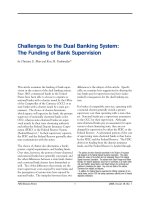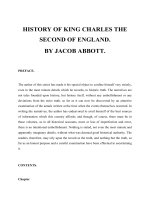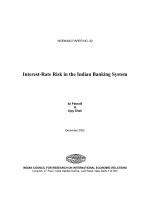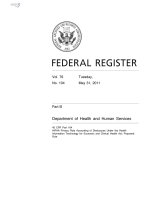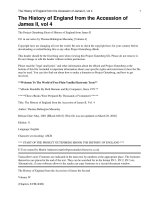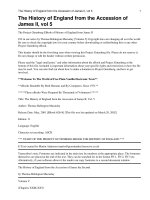History of crises under the national banking system
Bạn đang xem bản rút gọn của tài liệu. Xem và tải ngay bản đầy đủ của tài liệu tại đây (25.06 MB, 493 trang )
NATIONAL MONETARY CO.MMISSION
HISTORY OF CRISES
UNDER THE
NATIONAL BANKING SYSTEM
BY
o.
M. W. SPRAGUE
REPRINTS OF ECONOMIC CLASSICS
AUGUSTUS
M.
KELLEY· PUBLISHERS
NEW YORK I968
First Edition
I
9I 0
(Washington: Government Printing Office, 19 I 0
Reprinted 1968 by
AUGUSTUS M. KELLEY · PUBLISHERS
NEW YORK NEW YORK
10010
LIBRARY OF CONGRESS CATALOGUE CARD NUMBER
PRINTED IN THE UNITED STATES OF AMERICA
by
SENTRY PRESS, NEW YORK, N. Y. 10019
)
51sT CONGRESS}
2d Session
SENATE
j
(
DOCUMENT
No. 538
NATIONAL MONETARY COMMISSION
History of Crises under the
National Banking System
BY
O. M. W. SPRAGUE
Assistant Professor of Banking and Finance in Harvard University
Washington: Government Printing Office: 1910
NATIONAL MONETARY COMMISSION.
NSLSON W. Ax-DRIeH, Rhode Island, Chairman.
EDWARD B. VRESI.AND, New York, Vice-Chairman.
JULIUS C. BURROWS, Michigan.
JESSE OVERSTREET, Indiana.
EUGENB HAI.S. Maine.
JOHN W. WEEKS. Massachusetts.
PHILANDER C. KNOX. Pennsylvania.
ROBERT W. BONYNGE. Colorado.
THEODORE E. BURTON, Ohio.
SYI.VESTER C. SMITH. California.
JOHN W. DANIEl., Virginia.
LEMUEl. P. PADGETT, Tennessee.
HENRY M. ~EI.I.ER, Colorado.
GEORGE F. BURGESS. Texas.
HBRNANDO D. MONEY, Mississippi.
ARSENE P. PUJo, Louisiana.
JOSSPH W. BAILFY. Texas.
ARTHUR B. SHEI.TON. Secretary.
A. PIATT ANDREW, Special Assistant to Commission.
CONTENTS.
Page.
CHAP.
I.-The crisis of 1873--------------------------------Bank loans, 1869-1873
_
National-bank reserves, 1869-1873_
The concentration of bankers' deposits
_
Interest on deposits
_
The New York money market in 1872-1873-----The outbreak of the crisis
_
The closing of the stock exchange
_
Governmen t assistance
_
The effect of the panic on the New York banks _
_
Clearing-house loan certificates
Suspension in New York
._
The currency premium
_
Foreignexchange
_
Suspension throughout the country
.~ _~ __ . _
FIoarding
_
Pay-roll difficulties
_
The domestic exchanges
_
Bank failures
- - _- _
--_
Analysis of bank returns
The wise policy of the New Yorkbanks
_
_
No change in banking methods
Legislation after the crisis
_
IL-The panic of May, 1884---------------------------Failures and fraud
_
Clearing-house loan certificates
_
Analysis of New York bank returns
_
No equalizing of reserves
- _- _.
_
IlL-Financial stringency in 189°_
Central reserve cities
-_
_
New York reserves
Government assistance
_
Final stage of stringency
_
The banks and the government surplus
_
III
I
2
5
IS
20
24
35
38
40
43
45
53
56
58
61
68
71
75
81
82
89
1°3
1°5
108
1°9
113
117
120
12 4
12 4
12 7
135
14 1
149
Natlonal
Monetary
Gommlsslon
Page.
CHAP. IV.~The crisis
of 1893--------------------------------Monetary and banking movements, 1890-1893---The first stage of the crisis
_
The second stage of the crisis
_
The third stage of the crisis
_
Suspension of payments
_
The currency premium
.,.
_
The causes of gold imports
_
_
Suspension and hoarding
The effect of suspension on trade
_
The domestic exchanges
_
No changes in banking methods or legislation
_
V.-The crisis of 1907--------------------------------Banking movements, 1897-19°7
_
State banks and trust companies
-'
_
Elements of weakness in the New York money
market
_
The policy of the Treasury
_
The ultimate reserve
_
Indications of approaching reaction
_
The beginning of the crisis
_
Trust company difficulties
_
Unfortunate delay of the clearing house
_
Explanation of the suspension of payments by the
New York banks
_
Resumption delayed unnecessarily
..
_
The currency premium
_
Foreign exchange
Suspension throughout· the country
_
The domestic exchanges
_
Loan contraction
- _- - - - - - - - - - - - - - - - - _- - - _- The condition of the banks
_
_
Expansion of the circulating medium
The Treasury and the panic
_
_
..<
-
••
_
Conclu~on
NOTg A.-Extracts from the Annual Report of the Secretary of
the Treasury (William A. Richardson) relating to
the crisis of 1873--------.----------------------B.-Extracts from the Annual Report of the Comptroller
of the Currency (John Jay Knox) relating to the
crisis of 1873 - - - - - - - - - - - - - - - - - - - - - - - - - - - - - - - - - - C.-Extracts from the Annual Report of the Comptroller of
the Currency (H. W. Cannon) relating to the panic
_
of 1884--IV
153
153
162
16 7
175
180
186
19 1
195
199
2°3
210
216
216
224
260
277
280
282
286
29 1
297
3°3
314
3 16
318
32 1
33 2
345
Contents
Page.
NOT2 D.-Banking reform proposals in New York in 1894:
A. Address of George S. Coe - - - - - - - - - - - - - - - - - - B. Report of the committee of the New York
Clearing-House Association - __ - _- - - - - - - - - E.-Clearing-house loan certificates in 1890 - - - - - - - - - - - - _. F.-The Treasury and the money market in 189°- - - - - - - G.-Bank failures and suspensions in 1893 - - - - - - - - - - - - - - H.- A. Clearing-house loan certificates in 1893 __ ... _- - - - - - B. Report of the New York clearing-house loan committee - - - - - - - - - - - - - - - - - - - - - - - - - - - - - - - - - - - - - - - I.-TheBanks and the Panic of 1893. By A. D. Noyes --].-Report of the New York clearing-house committee,
acting as a loan committee in 1907 - - __ - - ___
K.-5ubstitutes for Cash in the Panic oj 1907. By A. Piatt
Andrew_______________________________________
v
371
381
387
393
400
406
409
413
428
434
HISTORY OF CRISES UNDER THE
NATIONAL BANKING SYSTEM.
CHAPTER 1.
THE CRISIS OF 1873.
The crisis of 1873 was preceded by four years of general
economic activity, which was by no means confined to the
United States. In agriculture, manufactures, and transportation much real progress was made, but, as subsequent
events proved, the pace was more rapid than was consistent with healthy development. Facilities for the production of m~any commodities were provided beyond the limits of profitable demand, and many enterprises w-hich were
enlarged upon a quite insufficient foundation of working
capital went to the wall when subjected to the strain of
crisis and depression. a As in 1857, the most serious weakness was disclosed in connection with railroad building.
Bonds often sold at a heavy discount had provided the
means for building many roads which were in advance of
any considerable population, and whose traffic proved
insufficient to meet fixed charges. The situation of other
roads was even more unsatisfactory. Before the crisis,
construction had had to wait upon the slow sale of bonds
a For the general economic situation both before and after the crisis see
"The Financial Crisis in America," by Horace White, in Fortnightly Review,
1876, pp. 810-82 9.
National Monetary
Commission
or the venturesome advances of bankers, and after the
crisis construction had to be discontinued altogether,
leaving a large mileage connecting nothing in particular. a
A long period of depression and recuperation was inevitable, and its advent could not have been long postponed.
But, as always happens, the exact moment of collapse was
determined by particular occurrences and might have
come a little earlier or at a somewhat later date.
BANK LOANS, 1869-1873.
The extent to which the banks may be held responsiblefor the unsound conditions which had developed before
the crisis of 1873 can not be determined exactly. In matters of this kind it is impossible to make a complete distinction between causes and effects. The average quality
of the loans of the banks must suffer if the general business
situation becomes unsatisfactory. On the other hand,
this condition may be in part a consequence of the failure
of the banks to exercise sufficient caution in granting
accommodation to borrowers. As will be seen later, few
banks failed during the crisis or during the subsequent
months and years of depression. And of the failures
which did occur hardly any involved serious loss to creditors. b There was, indeed, at the beginning of the crisis
evidence of momentary loss of confidence in the banks,
but this was primarily due to the disasters which had
taken place in other branches of business, particularly
among the railroads a~d the private bankers and brokers
aThe Commercial and Financial Chronicle, January 10, 1874, contains a
list of the railroads in default for nonpayment of interest on their bonds.
b See p. 81.
2
Crises
Under
National
Banking System
who dealt in their securities. There iS,however, one
method of estimating roughly the measure of responsibility which rests upon banks for the creation of cri~is conditions. If the expansion of loans has been unusually
rapid in the years just before a crisis, it must have contributed to the creation of the unhealthy situation. Moreover, the expansion of credit liabilities, which is created
by the increase of bank loans, may not be accompanied
by a parallel increase in the cash reserves in the banks.
In that case the banks may be so weakened that, though
able to withstand the shock of a crisis, they may not be
able to extend that aid to the business community which
may be reasonably expected from them. These are matters which can be analyzed statistically, and, so far as the
national banks are concerned, the periodical returns to
the Comptroller of the Currency, together with the weekly
returns of the clearing-house banks in the large cities,
provide a mass of data which is far more complete than
that in any other country. Moreover, for the particular
period under review the national-bank returns include a
larger proportion of the banking operations of the country than is the case in later crises, because of the comparatively small number of state banks and trust companies at that time. In the tables which follow comparisons will be based upon the returns of the banks in June
of each of the four years before 1873. The returns for
that season of the year happen to have been made at
almost the same date in successive years. They show the
condition of the banks at a time when they were least
influenced by special temporary circumstances, and when,
3
National Monetary
Commission
it may be added, the ratio of reserves to demand liabilities was most satisfactory.
In a country with a growing population there are normally increasing requirements for banking accommodation, and these requirenlents become particularly large
during years of active business. Unless, therefore, the
expansion of bank loans assumes large proportions, or
unless there is direct evidence of reckless banking methods, the creation of unsound business conditions can not
be laid at the doors of the banks simply because of an
increase in bank loans. In the particular case before us
the banks can not be said to have been particularly at
fault. The following table shows for June of each year
from 1869 to 1873 the number, capital, surplus and undivided profits, and the loans of the banks:
[In millions.]
National
banks.
June-
1869
1870
1871
7
_
_
_
1.619
1.612
1.7 2 3
1.853
1.968
_
18 2
1 8 73---------------------------------
Capital.
$422
427
450
47°
490
Surplus.
Loans.
$126
134
144
ISS
17 2
During the four years loans were expanded at a fairly
uniform rate, the total increase of $240,000,000 being
almost exactly 35 per cent. But in the meantime there
had been an addition of $114,000,000 to the investment
of the shareholders in the business. In the second place
it is to be noted that there were 349 more banks in the
national system at the close of the interval, 313 of which
were established in the South and West, which were insuf4
Crises
Under
National
Banking
System
ficiently supplied with banks in 1869. For this reason the
relatively large increase in loans in those parts of the
country from $130,000,000 to $238,000,000 does not
necessarily imply reckless or even unhealthfully rapid expansion of credit. Both relatively and absolutely the
movement of loans in the North Atlantic States was confined within moderate limits. In the case of the country
banks of those States the increase was from $235,000,000
to $300,000,000, while by the city banks it was from
$321,000,000 to $388,000,000. Finally, it should be noted,
that in New York, where the railroads were largely
financed and where the failures occurred which precipitated the crisis, there was strikingly little loan increase,
only $21,000,000-from $174,000,000 to $195,000,000.
The conclusion seems clear that the national banks can
not be held very largely responsible for creating unhealthy
conditions by an unwise policy of rapid loan expansion
during the years immediately preceding the crisis of 1873.
NATIONAL BANK RESERVES, 1869-1873.
Even a moderate increase in loans may, however,
weaken the banks if the greater liabilities thus created do
not rest upon increasing cash reserves. During the period
in question the operations of the banks were carried on
under highly exceptional circumstances as regards the
influences to which the reserves were subject, and a somewhat lengthy digression is necessary to explain the exact
situation. The money supply of the country was not
susceptible to any influences which might bring about an
appreciable change in its amount. The business of the
country was being carried on upon a fixed amount of
5
National
Monetary
Commission
inconvertible paper money. This currency was redundant, as was clearly indicated by the premium on gold,
but it was at a fixed point of redundancy, aside from
variations in requirements for the use of money. There
were almost exactly $700,000,000 of paper money in the
country throughout the four years, of which $356,000,000
consisted of legal..tender United States notes, and of the
remainder there were in 1869 nearly $300,000,000 of bank
notes and $46,000,000 of 3 per cent certificates. These
certificates did not circulate as money, but were available
for bank reserves. The act of July 12, 1870, authorized
an addition of $52,000,000 of new circulation, but provided at the same time for the withdrawal of the certificates. The change was made gradually, so that at no
time did it involve any appreciable change in the available
supply of paper money.a
Had the country been upon a specie basis the banks
might have increased their reserves by securing some
portion of current gold production. The banks and also
the Treasury did hold considerable amounts of specie
throughout this period, and the specie could be included
in the reserves required by law to be held by the banks,
but it could not be used to meet the ordinary requirements of depositors. It was constantly at a premium
of between 10 and 15 per cent. Like any other liquid
asset of a bank, it could be disposed of, but its sale could
not add to the money in circulation. The Pacific coast
was an exception, but the banks of that region were few
a The substitution of bank notes for certificates seems to have involved
some slight contraction, since the banks were required at that time to hold
a reserve against their circulating notes.
6
Crises
Under
National
Banking
System
in number, and their transactions may be disregarded
when considering the situation of the banks as a whole.
The banks had no' inducement to increase their specie
holdings, and in the country at large outside of New
York, they held but an insignificant portion of their
reserves in this form, seldom more than $6,ooo,ooo.a In
New York the case was quite different. In that city was
largely concentrated that portion of the business of the
country which continued to be carried on upon a gold
basis, such as the payment of import duties and foreign
exchange dealings. There were ,at all times large deposits
in the banks payable in gold, and there were regular gold
as well as currency clearings at the clearing house. The
gold holdings of the New York banks fluctuated widely,
but always formed a considerable portion of their total
reserves, varying in amount from one-third to one-half
that of their holdings of legal-tender notes. This gold
would have been a valuable resource had specie payments been resumed, but in the existing conditions it
was far less a real source of strength than would have
been an equivalent amount of legal tenders. The specie
held was required for the handling of the particular business transacted upon a gold basis, and although the
greater part of it was in the nature of a special deposit
earmarked and not available to meet the requirements
of depositors generally, it was all included in the statement of the reserves. On September 12, 1873, the deposits payable ilf gold were $12,101,000, and the banks
held in coin $14,586,000. b Practically the legal tenders
o See table in Comptroller's Report for 1873, p. XLIV.
PI Ibid., p. XXIX.
7
National Monetary
Commission
were the only reserve against the remaining $189,000,000
of deposit liabilities. In analyzing the reserves of the
New York banks, therefore, it will be necessary to distinguish carefully between the reserve which met the
legal requirements and the available reserve in actual fact.
As regards the legal-tender notes, it was impossible for
the banks to enlarge their holdings for several reasons.
Prices and wages were at a high level on account of the
redundancy of the currency, and consequently the requirements for money for everyday hand-to-hand use
were large and tended to increase with the growth of
population and business dealings. Moreover, a given
volume of transactions in commodities at the high level
of prices required correspondingly large credit accommodation expressed in terms of the depreciated paper.
The uses for the curency were, therefore, enlarged both
as to reserves and outside the banks and to an extent
which roughly corresponded with the high level of
prices. In these circumstances the increasing number
and capital of the banks did not tend to provide them
with more money for their operations. As the number
of banks increased the reserves became more widely
scattered, and consequently somewhat less available,
and larger capital and surplus would serve only to ofI!et
a part of the increase in demand liabilities created by
the expansion of loans. The conclusion is clear that it
was practically impossible for the banks to strengthen
themselves during a period of active business. On the
other hand, during a period of .inactive business it would
be certain that a larger proportion of the money supply
8
Crises
Under
National
Banking
/)ystem
of the country would accumulate in the banks because of the
diminished requirements for its use for everyday purposes
outside the banks. This was the situation early in 1869, at
the beginning of the period which we have taken for analysis.
Finally, it should be remembered that no distinction
was made between deposit and note liability in the national
banking law until 1874. Banks were required" to hold
the same kind of reserve for both kinds of liabilities, but
even during the worst moments of the crisis of 1873 the
liability for notes was not one which caused any depletion of reserves. For this reason, and because it simplifies comparison with the condition of the banks before
later crises, the relation between reserves and deposit
liabilities will be specially emphasized in analyzing the
situation of banks. In the following table, however, the
liabilities of the \banks for both notes and deposits are
presente1, together with their specie and legal-tender
reserves,Jrom June, 1869, to June, 1873:
[In millions.]
Circulation.
June--
Deposits.
Specie.
I
Legals.
- - - - - - - - - - - 1 - - - - 1 - - - - 1 - - - - - I1 - - 1869
1 8 70_
_
$18
31
- - - - - - - - - - - - - - - - - - - - - - - - - - - - --
18 71 - - - - - - - - - -- - - - - - - - -- -- -- - - -- --7
_
18 2
1 8 73- - - - - - - - - - - - - - - - - - - - - - -- - - - -- --
20
From this table it will be seen that in 1869 the banks
were exceedingly strong in cash reserves, holding nearly
28 per cent in proportion to their deposits. Notwithstanding the considerable increase in deposit liabilities
and the slight reduction in cash holdings, the proportion
9
National Monetary
Commission
of reserve was reduced to only 23 per cent in 1873. Even
if the liability for notes is included. the banks held 18
per cent in 1869 and 16,%' per cent in 1873, proportions
which, compared with the cash held in recent years by the
banks against deposits alone, were exceptionally large.
The percentage of reserve in June, 1873, was almost exactly
that of the banks in July, 1908, when, on account of generally inactive business, the banks held far larger reserves
than is now customary. It would seem, therefore, that the
cash foundation of the credit structure had not been
seriously weakened. But the amount of cash required to
insure the smooth working of the banking machinery of
a country can not be determined by purely arithmetical
calculations. Much depends upon the requirements which
are likely to be made for money, and also upon the amount
of cash which bankers have been accustomed to regard as
a minimum, in order to avoid reducing which they would
resort to drastic loan contraction and even to suspension.
In this connection the increase in the number of banksfrom 1,619 in 1869 to 1,968 in 1873-may be mentioned
as a factor which tended to weaken somewhat the effectiveness of the aggregate teserve. Each separate unit of
reserve was, on the average, somewhat smaller, and was,
therefore, less effective both for use and as a basis for
public confidence. Moreover, with the greater number
of banks, the difficulty was enhanced of securing that
cooperation which is required if the credit machinery is
to work smoothly in emergencies.
We must now enter upon a more detailed analysis of
the reserves of the banks, including not only the cash
held, but also the deposits "\vith reserve agents, which
10
Crises
Under
National
Banking System
make up so large a part of the reserves of most of the
banks in the national system. The country banks then,
as now, were required to hold in their own vaults cash
equal to at least 6 per cent of their deposit liabilities,
and also, until 1874, 6 per cent of their liabilities in the
form of bank notes. The remaining 9 per cent might be
held by approved agents in the" redemption cities," as
they were then called, a term which indicates the original
purpose of the arrangement-to provide facilities for the
regular redemption of circulation at the money centers.
The following tab~e shows the situation of the country banks
in June of each year from 1869 to 1873:
[In millions.]
-----------1--- - - - - - - - - Netdeposits
$209
$217
$231
$260
$292
Circulation_________________________
186
189
212
230
232
~~1~--5~
TotaL______________________
395
I"
Reserve _ _ _ _ _ _ _________ __ _________ _
82
'
Cash
--------------------------Due from reserve agents_____________
39
43
Ratiotodemandliabilities.............
Ratiotodeposits
20.81
22.6
22.81
20.6
39.2
42·4
43.8
39·2
92
101
43
49
42
59
II
102
r 08
45
57
47
61
27
37
The reserves of the country banks were well above the
requirements of the law. They held at all times in cash
alone more than 15 per cent of their deposit liabilities,
the ratio falling from 19 per cent in 1869 to 16 per cent
in 1873. If deposits with agents are included, the country banks held a reserve of much more than one-third of
their deposit liabilities, even at the close of the period.
The country banks, therefore, would clearly seem to have
been well supplied with funds to meet emergencies. It
should, however, be noted that, although cash holdings
II
National Monetary
Commission
had been increased by $8,000,000, deposits with reserve
agents had increased $18,000,000. This indicated a
greater power to withdraw money from the city banks
and also a slightly greater probability that it would be exercised in case of unusual demands upon the country banks.
There were at this time, as at present, two classes of
reserve or redemption cities. Fifteen cities were designated in the national banking law the banks of which
might become the agents of country banks. The banks
of these cities were required to hold a reserve of 25 per
cent, one-half of which might be deposited in the banks
of New York, which until 1887 was the only city of central
reserve rank. Taking first the banks of the fifteen reserve
cities, the following table shows their condition during
the four years before the crisis of 1873:
[In millions.]
- - - - - - - - - - - 1 - - - - - - - - - - - - ---Net deposits
Circulation
TotaL
- __ - - - - _-
-
- $r5r
7r
._ ____________
222
Reserve
- _- _- __ - - - - - - - - - - Cash
-------------------Due from reserve agents
- _- __
64
Ratio to demand liabilities
Ratio to deposits
--
.
--
45
r9
$r68
$r89
69
72
237
$r99
75
274
75
50
82
49
79
46
79
46
25
33
33
33
28.9
31. 8
31. 6
28.9
28.2
42.6
44·6
43·4
39.6
39· 5
- - -- - -- - -- - -- - -
The banks of the reserve cities, like the country banks,
held a reserve considerably above legal requirements
throughout this period. Taking liabilities for deposits
alone, the proportion of cash fell off somewhat from 29
per cent to 23 per cent, while the deposits with agents,
which increased rapidly until 1871, were thereafter prac12
Crises
Under
Natt'onal
Ban:kt'ng
System
tically stationary at $33,000,000. All of this amount
was, of course, held by the banks of New York, the banks
of which also held the deposited reserves of many of the
country banks. The position of the New York banks
was even more important as reserve agents than it has
been in recent years. They held in bankers' balances
quite 60 per cent more than the amount held by all the
banks of the reserve cities. Although the country banks
and those in reserve cities were well supplied with cash,
many of the former and all of the latter possessed the
right to withdraw large sums from New York, and, therefore, the condition of the New York banks is the most
important single factor to be considered in estimating the
strength of the system as a whole. For this reason it is
advisable to make a somewhat detailed examination of the
operations of the New York banks, and the following table
therefore includes a number of items which were not included in the tables which had reference to the other banks:
Abstract of the returns of the New York national banks, :£869-1873.
[In millions.]
1869
-------------1--- --- --- --- --Net deposits_ _ _ _ ___________________ $168
$190
$197
$r86
28
27
225
214
65
64
Circulation_ --------- - - - - - - - - - - - - - - -
35
33
TotaL _ _ _ __ _ __________ ______
203
223
Reserveheld
Specie
Legal-tendernotes
Due to national banks_______________
Due to other banks
61
72
76
14
18
II
IS
23
47
54
6.5
50
43
53
66
63
1_4_ _1_6_ _2_0_1_1_8
41
Ratio to demand liabilities_ - -- --- - --Ratio of legal-tender notes to deposits
lessspecieheldbythebanks
31
59
7_
1_
~ ~ ~ I ~--3-0-
I
30.531.4
13
31.5
27·3
25.2
National Monetary
Commission
In certain respects it will be noticed that the showing
of the New York banks was quite as satisfactory as that
of the other banks of the country. Demand liabilities
h~d increased only moderately, and since 1871 had actually
declined. The percentage of reserve to demand liabilities throughout the period was well above legal requirements. But the composition of the reserve was somewhat
less satisfactory, showing a distinct decline in the proportion of legal tenders. The specie holdings of the
banks, it will be remembered, were not at that time
available for ordinary purposes, and were largely held
to secure special deposits. The most significant indication of the strength of the banks, therefore, is gained
by taking the proportion of legal-tender notes to the
deposit liabilities less the amount of specie holdings.
Measured in this way it will be seen that there was a
serious change for the worse in the condition of the banks.
Against a deposit liability of $206,000,000 in 187 I the
banks held $65,000,000 in legal-tender notes, while in
1873 they held but $41,000,000 against $163,000,000 of
deposit liabilities. One further test, and a most important one, of the condition of the banks is still to be made.
Bankers' deposits show a rapid increase between 1869
and 1871 from $57,000,000 to $86,000,000. From that
point there was a moderate decline to $8 1,000,000 in
1872, and to $76,000,000 in 1873, but in 1871 the banks
held $65,000,000 in legal-tender notes, while in 1873
they held but $41,000,000. The other banks of the
country had largely increased their credits with New York
banks, which at the same time were much less well sup-
Crises
Under
National
Ban king/
System
plied with means to meet the heavy responsibility thus
created. The efficient working of the credit system was
evidently more and more dependent upon the ability of
the New York banks to meet all the demands of their
banking depositors, and this ability was diminishing.
THE CONCENTRATION OF BANKERS' DEPOSITS.
It is necessary to carry one step further this analysis
of the reserves of the national banks. Responsibility
for bankers' deposits did not rest upon the New York
banks as a whole. There were during this period some
50 national banks in the city, but the majority of them
were not reserve agents, and their statements show only
such small amounts due to banks as would naturally
arise in the course of the ordinary business of any bank.
The business of such banks was of a purely local character,
having no more general significance than that of banks
with an equal volume of business in Maine or Kentucky.a
During the period before the crisis of 1873 some IS
of the 50 New York banks held practically all of the
bankers' deposits acquired by the banks of the city,
and 7 of them held between 70 and 80 per cent of these
deposits. b These 7 banks were directly responsible for
the satisfactory working of the credit machinery of the
country, and their condition prior to the crisis must be
carefully examined.
aThe statement in the text may be qualified by the further observation
that the failure of a purely local New York bank might cause loss of confidence in the New York banks generally, including those which were of
national importance.
b The 7 banks were the First, Third, Fourth, Ninth, Central, Importers
and Traders', and Park National banks.
15
National Monetary
Commission
It has been too exclusively the practice to analyze the
condition of the banks as a whole or by localities, a
method which tends to obscure any real understanding
of the working of our system. It is of the utmost importance to locate the particular point at which the strain
of a crisis will be most directly and severely felt, and to
form an exact notion of the provision to meet it when it
does come. The returns of the condition of the individual
banks have been included in the annual reports of the
Comptroller of. the Currency for only one date in each
year-the return for the early autumn. For a purely
local bank such information is ample, but it is much to
be desired that more complete information·were provided
for those of the banks which are reserve agents. Such
data would be of value in following the changes which
take place in the banking situation as a whole, and would
also concentrate the attention of the public upon the
peculiar responsibilities of banks which hold bankers'
deposits. In the case of the New York banks further
information, though of a less comprehensive nature, is to
be had from the weekly clearing-house statements; but
as these statements for the individual banks were discontinued during the crisis of 1873 it is necessary to
take some other year in order to analyze the exact effects
of demands upon New York from the outside banks.
For this purpose the year 1872 has been selected. In
any case attention should be given to that year, since it
enables us to form an opinion of the power of the credit
structure to withstand financial strain of moderate
severity. Obviously, if moderate strain which can be
16
Crises
Under
National
Banking System
foreseen can not be met easily, a banking system is in
no position to meet the severe strain of a crisis.
The following table shows the condition on October 3,
1872, of the New York banks as a whole, that of the 7
banks which held the bulk of the bankers' deposits, and
the condition of the other 43 banks:
[In millions.]
50
Capital
_
Surplus and net profits
Circulation
Individual deposits
Due national banks
Due other banks
_
- __
_
_
_
- - - - _- _-
Total liabilities
_
Loans
_
Bonds
_
Due from other banks
_
Clearing-house exchanges and cash items
Bills of other national banks
Specie
_
_
_
Legal-tender notes
-
-
_
banks.
I
7
banks.
43
banks.
$71.3
$14·5
3I. 9
28.0
5·4
7·4
$56.8
26.5
20.6
188·5
60.6
14.8
34·1
I54·4
44·9
6.8
I5·7
395·1
113·1
183.4
58 . 2
1 2 5. 2
44·0
16·5
93·0
10.0
34·0
9.8
75·1
2·7
6.4
39·0
6·7
17·9
.6
8.0
2. I
1.1
5·3
15·5
23· 5
The situation disclosed by a survey of this table was
certainly extraordinary. Of the total bankers' deposits
of $75,4°0,000 the seven banks held $51,700,000, 72 per
cent; and if the more proper basis of net bankers' deposits
is taken, they held $45,000,000 out of a total of $58,900,000,
or nearly 76 per cent. But the accumulation of bankers'
deposits in a few banks is by no means the most striking
feature of the table. The capital and surplus of the seven
banks made up only 20 per cent that of all of the
banks, and their individual deposits were but 18 per cent
of total deposits. The bankers' deposits of the seven



